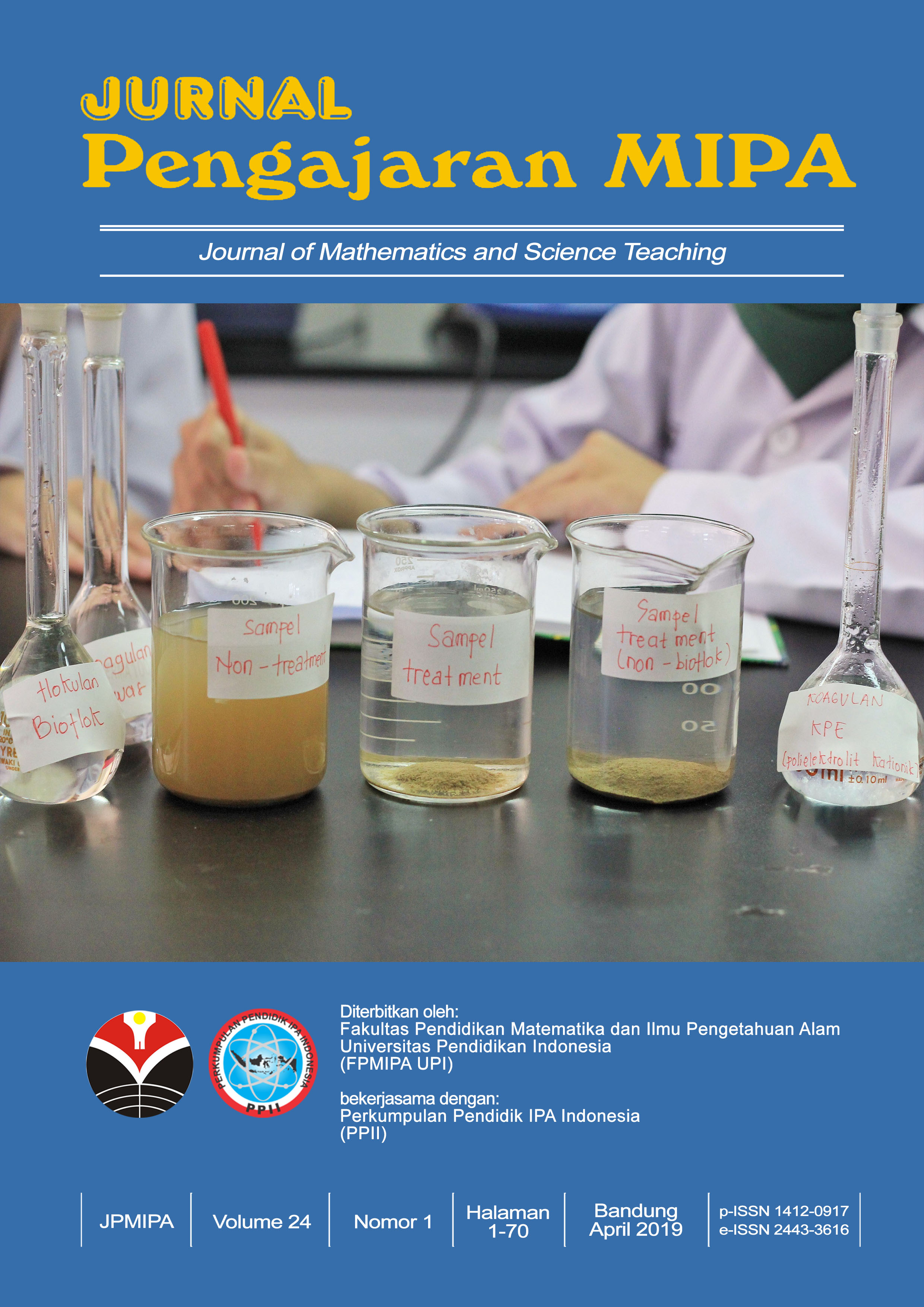ANALISIS KEBUTUHAN GURU KIMIA TERHADAP MATERIAL KURIKULUM MODEL “ATK” DAN POLA EDUKASI “ADIR”
Abstract
Keywords
Full Text:
PDFReferences
Adiningsih, NU. (2002). “Kualitas dan Profesionlisme Guru”. http://www. pikiranrakyat.com.
Anitah, Sri et al. (2007). Strategi Pembelajaran Kimia. Jakarta : Penerbit Universitas Terbuka.
Arifin, M. et al. (2007). Pengembangan Kurikulum dan Pembelajaran Kimia. Jakarta : Penerbit Universitas Terbuka.
Ball, D. L. and Cohen, D. K. (1996). “Reform by the Book: What Is-Or Might Be-the Role of Curriculum Materials in Teacher Learning and Instructional Reform?”, Educational Researcher, vol. 25, number 9, pp. 6-8, 14.
Borg, W. dan Gall, M. (2003). Educational Research: An Introduction. USA: Pearson Education Inc.
Clark, D. (2000). ADDIE Model. http://www.nwlink.com/~donclark/ hrd/ history/ history.html.
Cruickshank, D.R. (1990). Research That Informs Teachers and Teacher Educators. Bloomington, Indiana: Phi Delta Kappa.
Curriculum Council. (2003). Chemistry Syllabus. Retrieved 15/1/2004.
Dasuki, A. (2009). Reformasi Guru dan Tantangannya. Jakarta: Direktorat Jenderal Peningkatan Mutu Pendidikan dan Tenaga Kependidikan.
Davis, E.A. and Krajick, J.S. (2005). Designing Educative Curriculum Materials to Promote Teacher Learning. Educational Reseacher. University Michigan : Vol. 34, No. 3, pp. 3-14.
Depdiknas. (2005). Undang-Undang No. 14 tahun 2005 tentang Undang-Undang Guru dan Dosen. Jakarta: Depdiknas.
Depdiknas, 2005. Pembinaan Profesionalisme Tenaga pengajar (Pengembangan Profesionalisme Guru). Jakarta: Direktorat Jenderal Pendidikan dasar dan Menengah Direktorat Pendidikan Lanjutan Pertama Depdiknas.
De Vos et al. (2003). Chemistry Curricula for General Education: Analysis and Elements of a Design. In J.K. Gilbert, O. De Jong, R.Justi, D.F. Treagust & J.H. Van Driel (Eds.), Chemical Education: Toward Research based Practice, (Vol. 17, pp. 101 – 124). Dordrecht: Kluwer Academic Pubblishers.
Dharma, S. (2008). Penilaian Kinerja Guru. Jakarta: Ditjen PMPTK.
Howe, A.C. (1996). Development of Science Concept within a Vygostkian framework. Science Education, 72(1), 41-49.
Johnstone, A.H. (1993). The Development of Chemistry Teaching: A Changing reponse to changing demand. Journal of Chemical Education, 70(9), 701-705.
Karyadi, B. (2007). Pembaharuan dalam Pembelajaran Kimia. Jakarta: Penerbit Universitas Terbuka.
Kauffman et al. dalam Grossman, P. and Thompson, C. (2004). Curriculum Materials: Scaffolds for New Teacher Learning ?. University of Washington : Center for Study of Teaching and Policy.
Ma’ruf. (2009). Menjadi Guru Profesional. Suara Guru .Wordpress.com.
Pidarta. (1999). Pemikiran tentang Supervisi Pendidikan. Jakarta: PT. Bina Aksara.
Reitano, P. (2004). From Preservice to Inservice Teaching: A Study of Conseptual Change and Knowledge in Action. Australia: Faculty Education Griffith University.
Schneider, R.M and Krajcik, J., and Marx, R. (2000). The Role of Educative Curriculum Materials in Reforming Science Education. Fourth International Conference of the Learning Sciences. Michigan University. National Science Foundation as part of the Center for Learning Technologies in Education Grant.
Soetjipto, R.K. (1999). Profesi Keguruan. Jakarta: Rineka Cipta.
Sukmadinata, N. S. (2005). Metode Penelitian Pendidikan. Bandung: PT Remaja Rosdakarya.
Wardani. (1998). “Program Pemberdayaan Guru.” Jurnal Ilmu Pendidikan, November 1998, Jilid 6. No. 4 Hal. 289-301.
DOI: https://doi.org/10.18269/jpmipa.v16i1.36010
Refbacks
- There are currently no refbacks.
Copyright (c) 2021 Jurnal Pengajaran MIPA

This work is licensed under a Creative Commons Attribution-ShareAlike 4.0 International License.
JPMIPA http://ejournal.upi.edu/index.php/jpmipa/index is licensed under a Creative Commons Attribution-ShareAlike 4.0 International License
Jurnal Pengajaran Matematika dan Ilmu Pengetahuan Alam (JPMIPA) or Journal of Mathematics and Science Teaching
All rights reserverd. pISSN 1412-0917 eISSN 2443-3616
Copyright © Faculty of Mathematics and Science Education (FPMIPA) Universitas Pendidikan Indonesia (UPI)
View JPMIPA Stats









